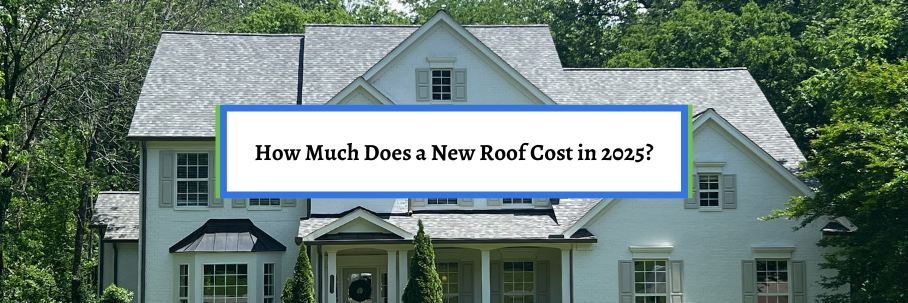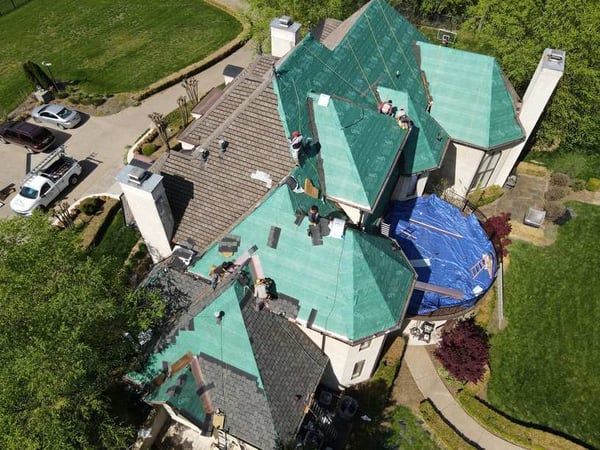How Much Does a New Roof Cost in 2025?

Do you need a new roof? Is your biggest concern how much a new roof will cost?
Most people's biggest concern before any purchase usually revolves around pricing. Unfortunately, getting a new roof is no different.
There’s no way around the fact that a new roof is a very expensive investment. The problem is that it’s hard to find honest and transparent pricing information in the roofing industry.
Well, you can’t prepare or know what to expect from a budget standpoint without knowing how much a new roof costs. I want to change that.
For over 30 years, the team at Bill Ragan Roofing has taken pride in helping homeowners understand the investment a roof replacement requires. That’s why I’ll answer the cost question head-on by giving you up-to-date roofing prices in 2025.
This article covers the following:
- What’s the average cost of a new roof in 2025?
- How much do the different roofing materials cost in 2025?
- What determines the cost of your new roof?
How much does a new roof cost in 2025?
According to last year’s 2024 COST VS VALUE REPORT, the average cost for a new architectural asphalt shingle roof (the most common type) in the United States is $30,680. This price includes tearing off and installing 30 squares of shingles with synthetic underlayment, galvanized drip edge, and aluminum flashing on a rectangular hip roof with two average-size skylights.
 (Roughly $30,000 roof)
(Roughly $30,000 roof)
However, this is a very general price that doesn’t account for area-specific pricing, roof size/complexity, or other cost factors (more on this later). For example, the average cost for a new asphalt shingle roof is $24,533 in our area of Nashville, Tennessee.
Even with the averages, you should expect a good-quality new roof to cost around $20,000 for a standard 3 bedroom, 2 bathroom middle-class home in 2025.
How much do the different roofing materials cost in 2025?
Knowing the average cost of a new asphalt shingle is a great starting point, but there are multiple roofing materials. In fact, there are two other types of asphalt shingles.
Also, many roofs won’t be 30 squares (3,000 square feet). So, having a price per square foot to apply to your specific roof’s square footage gives you a better idea of how much your new roof will cost.
Below is a table with the cost per square foot of the top roofing materials for a full roof replacement, including labor and material costs.
|
Roofing Material |
2025 Cost Per Square Foot |
|
$4.00 |
|
|
$6.40 |
|
|
$8.00 |
|
|
$4.50 |
|
|
$16.00 |
|
|
$30.00 - $50.00 |
|
|
$15.00 - $20.00 |
|
|
$25.00 |
|
|
$25.00 - $30.00 |
|
|
$14.00 |
|
|
$14.00 |
|
|
$14.00 |
(Click the link on an individual roofing material to learn more)
If you want to learn how to determine your roof’s square footage to apply these prices, check out How to Calculate the Square Footage of Your Roof. Just keep in mind that the numbers in the tables aren’t exact because every area and roofer has different pricing.
However, your new roof’s cost should be around the prices above for a full roof replacement based on the material.
What determines the cost of your new roof?
The roofing material you choose and the pricing in your area have a huge impact on pricing. However, there are more things a roofer takes into account to determine your new roof’s cost.
Below are the factors that directly impact the pricing when estimating a roof replacement.
The rest of the roof system’s components
While the main roofing material makes up the bulk of the pricing, the other components of a roof system also factor in. Every single piece plays an important role in keeping your roof sealed and home protected.
Including the main roofing material, the components you'll pay for when getting a new roof are:
- Decking (if any wood is compromised)
- Drip edge
- Underlayment
- Ice & water shield
- Starter shingles
- Roof vents and ventilation system
- Roof flashing
- Ridge capping
- Pipe boots
Every component and material listed here should be included in your roof replacement. If just one is missing or left off to save money, I guarantee you’ll have problems.
The size of your roof
The most obvious factor is the square footage of your roof. Your roof’s square footage affects the amount of materials used, labor, and time needed to complete the job.
I say square footage because it’s what homeowners are familiar with. However, you’ll also hear roofing contractors say “price per roofing square” (100 square feet) when getting estimates.
Your roof’s accessibility
A roofing contractor uses an access point for every part of the roof replacement process. The harder your roof is to access, the more it affects the cost.
Some things that make a roof hard to access are:
- Landscaping or rows of bushes below the roof line
- A fence around the property
- No paved surface near the access point
- The neighboring houses are close
Even if the roofs are the exact same, a home with an easy access point will have lower labor costs than a home with the things listed above.
The number of penetrations your roof has
A penetration is anything that comes through a roof, like plumbing vents, gas vents, kitchen/bathroom vents, skylights, and chimneys. The more penetrations your roof has, the more it impacts both material and labor costs.
Smaller pipes or vents won’t add much, but skylights and chimneys have a bigger impact on a new roof’s cost because they take longer to flash and work around.
Your roof’s pitch
Roof pitch is your roof's slope (angle) that affects square footage, material options, and installation complexity. The steeper the roof pitch, the more expensive a roof replacement will be.
Material costs will be higher from increased square footage on a steeper pitch, but what it really affects is labor costs. It takes longer to work on a steep pitch because installers take more safety measures (harnesses and tying off).
They also can’t move around or access the materials on a steep roof as easily as they would on a walkable pitch. Because of all this, pitch is one of the biggest factors a roofer considers when determining a new roof’s cost.
Roof complexity
A roof’s complexity is how cut up it is with different facets, hips, valleys, and how many stories it is off the ground. The complexity of your roof greatly affects both labor and material costs.
 (Example of a very complex roof)
(Example of a very complex roof)
This is simply because any roof with moderate complexity is more difficult, requires more attention to detail, and takes longer to replace than a standard ranch style.
The number of layers and dump fees
Tearing off your old roof always factors into the cost of a new roof, both in labor and dump fees. However, a roof with more than one layer requires more labor and increases the amount of debris coming off your roof.
 (Roof with two layers)
(Roof with two layers)
This not only increases labor costs for tear-off and clean-up but also the dump fees when getting rid of the torn-off materials. There will be an initial labor and dump fee for the first layer, plus an added cost for each additional layer.
The labor and time to replace your roof
As I’m sure you noticed, labor and time have a huge impact on all the factors that I’ve mentioned. Anything that takes time and labor always factors into a new roof’s cost.
Unfortunately, there’s no set price for labor and time because it varies by roofing contractor and crew size. And the longer they're working on your property, the more time factors into the pricing.
The overhead of the roofing contractor you hire
Just like labor costs, every roofing company has different overhead and operating costs. These operating costs plus the required profit factor into each line item to keep the business running.
Some common operating costs are:
- Building cost and utilities, shop, and truck yard
- Advertising and promotions
- Vehicles (fuel and insurance)
- General liability insurance
- Workers compensation insurance
- Licenses and bonds
- Training
- Payroll and payroll taxes
- Taxes (Federal and local government)
These are just some fixed operating costs to run a roofing company, which must be accounted for in every job. And as you know, profit is required to grow, continue operating, and be there to honor warranties in the future.
What should you consider before getting a new roof in 2025?
Now you know the average cost and cost per square foot of a new roof right now in 2025. You also learned the things about your roof and home that’ll directly impact your new roof’s cost.
At this point, you have an idea of the budget you’ll need for a new roof. But while pricing and budget are always huge considerations, there’s more to consider before starting the roof replacement process.
In fact, considering some simple things can help you avoid making the wrong decision or getting taken advantage of by a bad roofing contractor. That’s why I wrote another article breaking down the main things every homeowner must consider before getting a new roof.
Check out The 5 Things to Consider When Replacing Your Roof to learn what you should think about before starting the roof replacement process.


